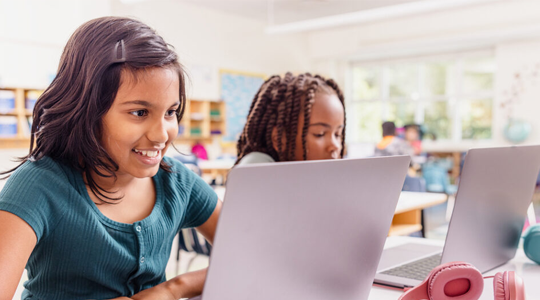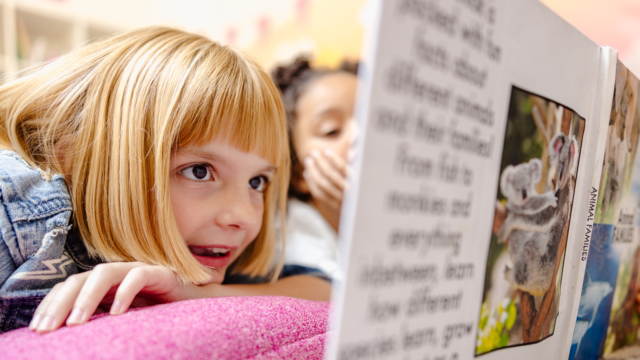
Relationships must be at the heart of what we do as teachers. Taking the time to connect and learn about our students makes all the difference in the world.
I began my teaching career many years ago as a second-grade teacher and have taught most Grades K–7. I love what I do. I especially love my time reading aloud to my students, no matter their ages. It brings us together and allows for all students to participate.
It wasn’t always that way. I must say I made my share of mistakes along the way: too many questions, low-level questions, and covering too much in one book, to name a few. Reflection and being open to ongoing learning have helped me grow. Through the years, I have honed my practice and now realize the value of purposeful planning and reflecting.
What is an interactive read-aloud?
Imagine a lesson where students and teachers have a conversation about literature. Interactive read-alouds offer an opportunity for whole-group teaching involving all students. The teacher plans for conversations and makes decisions about when they will occur during the lesson.
Through this careful approach, teachers can intentionally think about and plan for:
- Book selection
- Text features
- Questions to ask
- Modeling of strategic reading behaviors and fluency
- Places to stop for interaction
All students can be included using strategies such as a turn-and-talk or a think-pair-share, which enable students to construct knowledge with their peers. Interactive read-alouds are engaging because students are active rather than passive, and students participate by listening and speaking with the teacher and their classmates.
Why interactive read-alouds?
Interactive read-alouds allow us to construct knowledge with all students. During our time together, we consciously build relationships and create a community of collaboration. We can read books that students may not have the ability to read on their own, so the experience is both powerful and motivating.
All students can participate because we plan, read, problem solve, question, and model what readers do, which frees students up to focus on the meaning of the text. We are scaffolding the learning process, making it accessible to all.
Book selection is everything
Selecting books with our students in mind shifts the focus from teacher-driven to student-driven. Considering students’ strengths and interests lets students know that we care about them. If our goal is to create a love for reading, curiosity, engagement, and learning, then we have to choose books we know students will be excited about.
A book may have pertinent content related to real problems students face in and out of school. We might even allow students to select future books that we can read. Getting to know our students and their needs will help us determine our why and purpose. Our why is so important.
Some questions we can consider are:
- What are my students’ interests, and what might they need next?
- Does this book build on the previous books?
- Does it build on background knowledge?
- What’s our purpose for that particular book as it relates to what we want our students to gain?
- Is there an opportunity to teach students about how to communicate effectively?
The deeper meaning of the text
Authors often have an overall message they want their readers to understand. These overall messages are subtle, and taking the time to understand the deeper meaning can help us facilitate learning. Our aim is for students to not only learn about the content but also the important underlying message. Some valuable underlying messages relate to empathy, respect, kindness, problem solving, interpersonal skills, and teamwork.
Questioning strategies
Planning for questions to ask students ahead of time is beneficial for several reasons. We are better able to plan based on our students’ needs and not just the text. In addition, it frees us up to enjoy the text with students instead of thinking as we are reading. We target the level of questions to ask so the lesson goes smoothly. The questions we plan for are one part, but there are other aspects we need to consider:
- Where are some good places to stop reading in a book to allow students to think and talk about the meaning?
- Are our questions rigorous enough?
- How relevant are our questions?
- What do our students need to think critically about the books we select?
Planning such as this takes time but allows us to see what types of questions we are asking.
Plan for student involvement
Involving all students is a must. Students have to know that they are in a safe place and that their voice is heard. We do so by building a trusting and respectful environment. Building meaningful conversations allows students to participate and interact with one another about what they are learning.
Here are some ways we can teach and include all students in our interactive read-alouds:
- Teach accountable talk: We can teach students how to communicate effectively in a thoughtful manner.
- Think, pair, and share OR Write, pair, share: Students are given a minute or two to process the question posed, respond, and pair up with a partner to share. These interactive read-aloud strategies allow students to engage in the text and listen to others.
- Use technology: Students reflect on questions in an app such as Mentimeter, which allows for real-time voting and reflection. Students can respond and also read and reflect on others’ thoughts.
- Reflect at the beginning, middle, or end and share with a partner (verbally or on paper).
- Complete sketchnotes: This type of note-taking challenges students to think about important ideas and represent them with visuals and words.
Sometimes, we try to do too much during an interactive read-aloud. When this happens, we can lose sight of our purpose, and it could create confusion for our students. On the other hand, being purposeful with our planning makes a greater impact on learning. We can think about how to create a balance between all components of our interactive read-aloud. Students are better able to process, reflect, and collaborate when we are clear with our purpose. It will also broaden their understanding of the reading and thinking process.
Teaching in action
There are three parts of the read-aloud: before reading, during reading, and after reading. We can think about how and when we want students to participate in the discussion. Being purposeful during each component is key.
Before reading:
- Engage readers by sharing the purpose of the lesson and why it’s important for readers.
- Ask questions that relate to the topic of the book.
- Preview the book without giving too much away.
- What do you know and want to know?
During reading:
- Model strategic reading behaviors and comprehension strategies.
- Share what we notice about the text through the use of the strategy, think-alouds, where we verbalize our thoughts out loud so students can hear what we are thinking and why.
- Ask interactive read-aloud questions that were created during the planning phase.
- Incorporate strategies that allow students to think and talk about the text.
After reading:
- Have a conversation about the overall meaning of the text: What surprised you? What did you learn? What questions might you still have?
- Extend the learning: How can this lesson connect to other parts of our literacy curriculum, including writing?
Teacher reflection
Reflecting on our lessons is key to making improvements. Here are some questions we can use to guide us in this process:
- How did the students answer questions?
- Were all students engaged?
- Were the activities chosen for students to reflect on appropriate?
- What other data do we have to reflect upon?
- How did the students interact with one another?
- At what point did we stop for think-alouds? Was that the best place?
- What’s next for students during our interactive read-alouds, and how might we weave what we do as readers into reading lessons or other parts of our literacy curriculum?
- Are there other opportunities to have students independently or collaboratively practice strategic reading behaviors, questioning, and comprehension strategies?
Taking the time to write down our reflections will challenge us to think about what went well, what didn’t, and what’s next. We can analyze the data we collect from our conversations and activities to inform our practice as well.
Interactive read-alouds play an important role in our teaching and bring everyone together. If we want students to participate, we must build relationships and create a safe and caring environment. We must find ways to engage all students, think about their needs as learners, and teach from there.
The views expressed in this article are those of the author and do not necessarily represent those of HMH.
***
Discover a proven path to reading and writing success for students in Grades K–6 with HMH Into Reading, and our Spanish program ¡Arriba la Lectura!
For students in Grades 6–12, HMH Into Literature creates critical readers using culturally relevant texts that relate to students’ lives.
This blog, originally published in 2018, has been updated for 2025.
Be the first to read the latest from Shaped.














